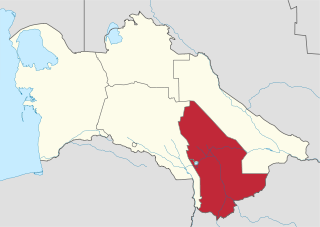
The economy of Turkmenistan continues to recover from the 2014 downturn in hydrocarbon prices, but remains "in the grip of its worst economic crisis since the immediate post-independence period, driven in part by low gas prices, the suspension of gas exports to Russia between 2016 and 2019...and poor harvests." Former President Gurbanguly Berdimuhamedow at a session of the Cabinet of Ministers on March 11, 2021, called the rate of GDP growth unsatisfactory. When discussing the 2021 government budget, he noted that 2021 would be "as difficult" a year as 2020 had been.

Ashgabat or Asgabat, is the capital and the largest city of Turkmenistan. It lies between the Karakum Desert and the Kopetdag mountain range in Central Asia, near the Iran-Turkmenistan border.

Ahal Region is one of five provinces of Turkmenistan. It is in the south-center of the country, bordering Iran and Afghanistan along the Kopet Dag Range. Its area is 97,160 km2 (37,510 sq mi) and population 939,700.

Balkan Region is the westernmost of the five regions of Turkmenistan. Clockwise from north it borders Kazakhstan, Uzbekistan (north); two provinces of Turkmenistan (east), Iran (south) and the Caspian Sea (west). The capital city is Balkanabat, formerly known as Nebit Dag. The region's boundaries are identical to those of the former Krasnovodsk Oblast' , a Soviet-era province of the Turkmen Soviet Socialist Republic. This oblast was liquidated and restored repeatedly in the 20th century, concluding with its abolition in 1988. However, the administrative boundaries of the region were restored in 1991 when Balkan Region was established.

Daşoguz Region is one of the regions of Turkmenistan. It is in the north of the country, bordering Uzbekistan. The area of the province is 73,430 square kilometers, and the total population is 1,370,400. The capital is Daşoguz.

Lebap Region is one of the regions of Turkmenistan. It is in the northeast of the country, bordering Afghanistan, Uzbekistan along the Amu Darya. Its capital is Türkmenabat. It has an area of 93,727 square kilometers, and a population of 1,334,500 people.

Mary Region is one of five provinces in Turkmenistan. It is located in the south-east of the country, bordering Afghanistan. Its capital is the city of Mary. Its area is 87,150 km2 (33,650 sq mi) and population 1,480,400. The average population density is about 15 persons per square kilometer, but it reaches 150–200 per square kilometer in the most developed oases.
OJSC Turkmenistan Airlines is the flag carrier and only airline of Turkmenistan, headquartered in Ashgabat. It operates domestic and international passenger and cargo services mainly from its hub at Ashgabat International Airport.

The People's Council of Turkmenistan is the upper chamber of Turkmenistan's Parliament, the "National Council". It consists of 56 members, 48 elected from the five provinces and the capital city of Ashgabat, and 8 appointed by the president.

The State Security Council of Turkmenistan is an important decision-making body in the field of the defence of Turkmenistan. It is the highest decision-making body in the armed forces next to the Ministry of Defense and the General Staff, with its members directly advising the President of Turkmenistan on matters of national security.

The districts of Turkmenistan are territorial entities below the provinces of Turkmenistan. They may be counties, cities, or boroughs of cities. The heads of the districts are appointed by the President of Turkmenistan.
Gökdepe District is a district of Ahal Region, Turkmenistan.
Institute of Telecommunications and Informatics of Turkmenistan is the largest institution of higher education in Turkmenistan, located in the capital of Ashgabat. Founded in 1992, prepares professionals and higher vocational education for railway transport and other sectors of the economy. Its rector was Nurnepes Annaevich Kuliev, until the university was abolished.

Archabil Avenue is a motorway in Ashgabat, Turkmenistan. The eight-lane motorway has a length of 25.5 kilometres, and contains a dividing strip of more than 30 metres width.

The Cabinet of Ministers of Turkmenistan is the chief executive body in Turkmenistan. The Cabinet of Ministers of Turkmenistan is appointed by the President of Turkmenistan who is both the chief of state and head of government. In addition to holding specific portfolios in most cases, six deputy chairpersons of the Cabinet of Ministers may also be assigned responsibility for oversight of a province of Turkmenistan or of the capital city.

Serdar Gurbangulyýewiç Berdimuhamedow is the third and current president of Turkmenistan, serving since 19 March 2022. Berdimuhamedow had previously served in several other positions within the government of his father, Gurbanguly Berdimuhamedow.
Isgender Handurdiyevich Mulikov is a Turkmen politician who was Minister of Internal Affairs from 2009 to 2019.
Batyr Amangeldiyevich Amanov is a Turkmen politician who has been serving as the chairman of the Türkmengaz State Concern with rank of minister of state.

People's Council elections were held in Turkmenistan on 28 March 2021 to elect 48 of the 56 members of the People's Council or Halk Maslahaty. Another eight were appointed by the president on 14 April 2021.
Shamuhammet Durdylyyev is a Turkmen politician, who has served as deputy chairman of the Turkmenistan government for construction and industry and as mayor of Ashgabat, Turkmenistan's capital city. He is currently on the board of directors of the consortium of construction companies responsible for building the "Ashgabat City" residential development.
















